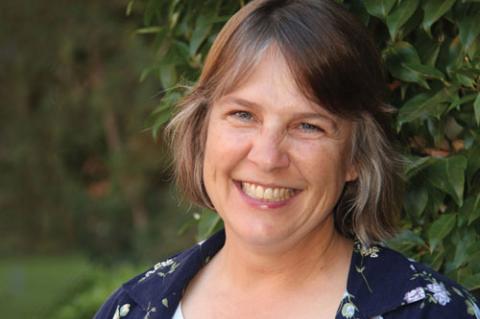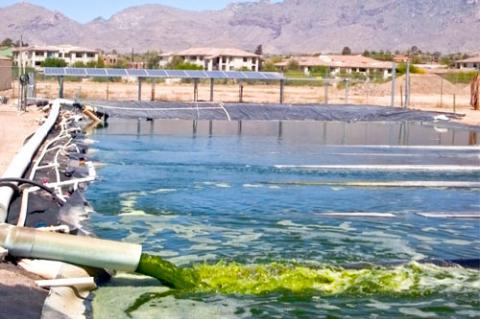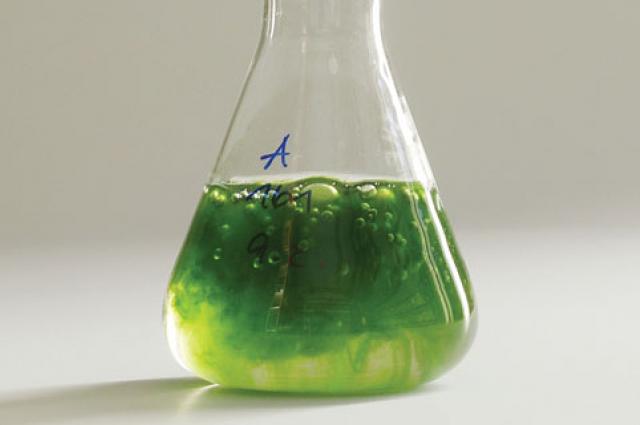Energy Department Awards UA-Led Team $8M to Research Algae Biofuel
Can algae farming really supplant oil and gas drilling over time? That’s the big question the University of Arizona’s Kimberly Ogden, chemical and environmental engineering professor, has been asking of simple algae, the green stuff with the right stuff to potentially fuel the future.

Ogden is not alone in the quest to mass-produce a bio-oil to reduce dependence on petroleum and its many environmentally unfriendly byproducts. The challenge is to find a substance capable of becoming fuel for transportation, feed for animals, fertilizer, and high-value products such as bioplastics or pharmaceuticals. Ogden is focused on determining the efficacy of one source in particular: algae.
The University of Arizona is the lead institution for the Regional Algal Feedstock Testbed, or RAFT, partnership, which was recently awarded $8 million over four years by the Department of Energy to research how algae can be grown year-round outdoors in open ponds in different climates. In addition, other researchers and companies will collaborate with the research team to develop harvesting and conversion processes to produce biofuels and bioproducts.
“Our job is to figure out how we take algae and turn it into biofuels, bioproducts and feed in an economically sustainable way. We want to make a biofuels industry in America,” said Ogden, UA’s primary investigator on the RAFT project.
Ogden and RAFT researchers from Pacific Northwest National Laboratory, New Mexico State University and Texas A&M AgriLife are optimizing algal growth systems to yield more biomass and lipids, developing methods of recycling and reusing water, and experimenting with methodologies for growing various algae strains.

The majority of the research will be done using UA’s Algal Raceway Integrated Design, or ARID, system, which was designed and patented by Ogden’s research partners Randy Ryan, of the Arizona Agricultural Experiment Station, part of the UA College of Agriculture and Life Sciences; Pete Waller and Murat Kacira, of the department of agricultural and biosystems engineering; and Perry Li, of the department of mechanical and aerospace engineering. The research team also includes Judy Brown, a professor in the UA School of Plant Sciences.
“Right now the process is pretty labor intensive,” Ogden admits. “But part of the goal of this grant is to better understand the relationships between flow rate, nutrients, pH, temperature, and algal productivity so we can optimize system performance and have an automated system.”
Why algae? Didn’t we already try corn, cotton, soybean, sunflower and palm oil?
When gas prices skyrocketed in 1978 and lines at the pump grew daily, the government began to seriously explore algae as a fuel source. After testing more than 3,000 types, scientists concluded that production of algae-based fuel with consistent quality, widespread availability, and competitive pricing might even outperform petroleum by burning cleaner and more efficiently.
Algae are simple, plant-like organisms without roots, stems or leaves, so there’s very little waste. An estimated 300,000 varieties grow all over the world in seawater, freshwater and wastewater. Most use sunlight to make their own food. So Arizona is a good place to grow algae. Others require no light and assimilate organic compounds around them as food. Up to half of algae’s composition can be lipid oil that can be high in omega-3 content or readily converted to biodiesel or jet fuel.
The remaining biomass has numerous applications from feed to eco-plastics to nutritional supplements. In her 2010 TEDX Tucson talk, Ogden explained that algae contain a lot of protein and carbohydrates, so the plant can be used as both a fuel and a food. Because algae are ubiquitous, valuable land and food resources won’t be displaced or depleted. “To tackle the problem of large-scale production of algae for fuels and other products, we need to have a better understanding of everything from the biology to the interfacing with existing petroleum processing plants,” Ogden added.
UA’s contribution to this project focuses on water usage and quality issues, plant biology, reactor design, and the production of various algae strains for advanced testing.
“The really big picture of this whole project is to determine how much oil we can get from algae over time. We need to see how feasible it is to run the ARID raceways 24/7 outdoors under different conditions,” Ogden said. Her team will compare the ARID reactor design with others to find the system that uses the least amount of energy to obtain the highest productivity in four different areas of the country: Tucson, Ariz.; Pecos, Texas; Las Cruces, N.M., and the Pacific Northwest.”
By growing algae in its patented raceways, UA will be able to sustain growth year-round in temperature-controlled environments. “If someone wants to test a harvester to concentrate the cells, or a reactor to convert biomass into fuel, this can be done at our Tucson site,” Ogden said. “Evaluating a variety of types of equipment at a pilot plant scale is part of the whole process of making fuel.”


